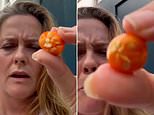A man was stunned to learn his $4.99 vase from Goodwill was actually worth up to $100,000.
The 1920 Overbeck yellow vase featured on an Antiques Roadshow episode earlier this week when an unidentified guest brought it to an event in Indiana.
The owner of the piece told appraiser David Rago that he and his wife were shopping at Goodwill when he spotted the 'beautiful' product on a shelf.
When told it could fetch between $50,000 and $100,000 at auction, the man replied: 'My heart is thumping!'
The shopper added: 'I knew it was good quality, but I knew nothing about it, so I picked it up and looked,' said the owner of the vase.

A man brought a 1920 Overbeck vase to an event that aired on Antiques Roadshow. Appraiser David Rago told him the vase would sell anywhere between $50,000 and $100,000
'It had markings, and I thought, "Well, I don't know who it is, but for $4.99, I'm going to buy it."'
Rago briefly described Overbeck pottery and turned the vase over to show the owner the 'OBK' marking that is used on nearly all its items.
He added that the initials 'E' and 'F' below the 'OBK' were the initials of two of the sisters who created the vase.
The female potters created several pieces of work during the 1900s, and the appraiser believed that the women did their best work around the 'late teens, early 20s.'

The appraiser spoke highly of the vase's design that features 'a geometric distillation'

Rago explained that he knew a tree was in the design because of the branches and the leaves, which are shown as triangles
The 1920 vase 'falls into that power alley,' according to Rago.
He added: 'The conventionalized design is an arts and crafts period design technique that uses a geometric distillation of the original design.'
'You can see that conventionalization in this design. You've got the repeated design. It's five or six times around the vase.'
The appraiser also mentioned the running man in the striped suit, and the 'big pink sun' that is shining through a tree.
Rago explained he knew it was a tree because of the branches and the leaves, which are shown as triangles.
'It's colorful, it's hand thrown, it's tooled... It's a seriously good piece of Overbeck.'

David Rago told its owner that the initials 'E' and 'F' below 'OBK' were of two of the sisters who created the vase
Overbeck pottery was produced between 1911 and 1955 by Margaret, Hannah, Elizabeth, and Mary Frances Overbeck.
The majority of the four sisters' work was inspired by their surroundings, according to Waynet.
The sisters collaborated with one another on most of their pieces, and the 'E' and 'F' initials on the Antiques Roadshow vase stood for Elizabeth and Frances.
The women went on to win awards for their work in places like Paris, Chicago, and New York, and their work is featured in museums nationwide.
Art enthusiasts can also take a look at their work at the Overbeck Pottery Museum in Cambridge City.
Their pieces occasionally pop up on auction websites, and one of their works from 1915 was auctioned off for $52,920 last April.
The expensive vase's worth was estimated to be $35,000–45,000 before it was purchased.





































































































































































































































































































































































